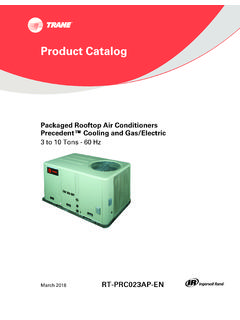Transcription of Internal Fault Detection in Distribution Transformers
1 Internal Fault Detection in Distribution TransformersFMEA Energy Connections ConferenceNovember 6, 2015 Paul Henault IFD CorporationWhy is Internal Fault Detection important?Why Internal Fault Detection is importantLinemen Safety Operating challenges Crew pressures Risk every time we re-closeTroubleshooting Effectiveness Speed AccuracySystem Reliability Reduce outage times SAIDI/SAIFIWhy Internal Fault Detection is importantWhat does an Internal transformer Fault look like? A rapid, transient pressure rise occurs in every Internal arcing Fault Variable peakpressure Consistent rate of riseWhat does an Internal transformer Fault look like?
2 Certification tests at Powertech Labs500A testArc VoltageFault CurrentPressure RiseNormal FaultIFD activates before peak~ 3 psiWhat about PRV s? PRV operation:P > 10 2 psi Internal Fault (Poppet style PRV) does not have time to react to the overpressure rates of rise and values produced when low-impedance faults occur. A. Even et al., Safety of Distribution Transformers against Internal failure , Conference Publication No. 438., IEEE, 1997 What causes transformer fuses to blow?Causes of transformer fuse operations46%20%15%10%5%4%0%5%10%15%20%2 5%30%35%40%45%50%No DamageFuseTransformerLV WiresConnectorsFuse Holder* Source.
3 Causes of padmounted transformer fuse operations Internal Transformer Faults Secondary Faults Overloads Oil Temperature (Dual Element Fuse)Current Industry Practices1)Automatic Replacement2)Field Testing3)Trial & Error1)Always wear the appropriate personal protective equipment including fire retardant clothing,hard hats, safety glasses and rubber )When performing any close inspections of or repairs to the transformer always deenergizethe unit and take precautions from any sources of power including customer )Prior to re-fusing Transformers , make a thorough inspection of the transformer and thesurrounding area, looking for indicators such as: animal carcasses, bulged tank or cover,discolored tank, oil leak, burned oil aroma, flashed or broken bushings, any short circuitssuch as wrapped wires in the secondary or )Prior to re-fusing Transformers , test the transformer with an approved instrument such as aTransformer Turns Ratio tester.
4 Some companies require some form of testing on everytransformer before they are )When re-fusing a suspected faulty transformer, position yourself as far away as possible byusing an extendable live line tool. Some companies specify maintaining a distance of atleast 10 ft. when re-fusing )When re-fusing a suspected faulty transformer, always disconnect the customer s )Test the transformer with a smaller test fuse. (Some companies have test fuse tables basedon the transformer size and voltage).8)If the transformer blows a fuse and the pressure relieve valve has operated, do not re-fuseand proceed with )If the transformer has an auxiliary current limiting fuse that has blown, do not re-fuse;proceed with replacement.
5 Checking transformer condition10)Maintain proper distance when re-fusing. In this condition: do not refuse11)Always make sure the neutral is connected first before connecting a transformer and that itis removed last if disconnecting a )Do not allow the paralleling of Transformers across any point that might be used to isolate aline section, such as switches, disconnects and double dead ends to avoid the possibility ofback feed into a cleared line )Always wear rubber gloves when working on the secondary side of a suspected )Take precautions when removing the lid from a suspected faulty transformer by operatingthe pressure relief valve.
6 If it is an older unit without a valve, tie a sling over the lid beforeloosing the )Some companies have established step-by-step procedures for investigating transformerproblems while others allow the lineworker to access the situation and take precautionsthey deem necessary within mandatory safety )It is recommended that step-by-step procedures be developed as they are good trainingaids and can serve as a refresher for lineworkers. They also help ensure certain key stepsare followedSample utility procedures1)Always wear the appropriate personal protective equipment including fire retardant clothing,hard hats, safety glasses and rubber )When performing any close inspections of or repairs to the transformer always deenergizethe unit and take precautions from any sources of power including customer )Prior to re-fusing Transformers , make a thorough inspection of the transformer and thesurrounding area, looking for indicators such as.
7 Animal carcasses, bulged tank or cover,discolored tank, oil leak, burned oil aroma, flashed or broken bushings, any short circuitssuch as wrapped wires in the secondary or )Prior to re-fusing Transformers , test the transformer with an approved instrument such as aTransformer Turns Ratio tester. Some companies require some form of testing on everytransformer before they are )When re-fusing a suspected faulty transformer, position yourself as far away as possible byusing an extendable live line tool. Some companies specify maintaining a distance of atleast 10 ft.
8 When re-fusing )When re-fusing a suspected faulty transformer, always disconnect the customer s )Test the transformer with a smaller test fuse. (Some companies have test fuse tables basedon the transformer size and voltage).8)If the transformer blows a fuse and the pressure relieve valve has operated, do not re-fuseand proceed with )If the transformer has an auxiliary current limiting fuse that has blown, do not re-fuse;proceed with replacement. Checking transformer condition10)Maintain proper distance when re-fusing. In this condition: do not refuse11)Always make sure the neutral is connected first before connecting a transformer and that itis removed last if disconnecting a )Do not allow the paralleling of Transformers across any point that might be used to isolate aline section, such as switches, disconnects and double dead ends to avoid the possibility ofback feed into a cleared line )Always wear rubber gloves when working on the secondary side of a suspected )Take precautions when removing the lid from a suspected faulty transformer by operatingthe pressure relief valve.
9 If it is an older unit without a valve, tie a sling over the lid beforeloosing the )Some companies have established step-by-step procedures for investigating transformerproblems while others allow the lineworker to access the situation and take precautionsthey deem necessary within mandatory safety )It is recommended that step-by-step procedures be developed as they are good trainingaids and can serve as a refresher for lineworkers. They also help ensure certain key stepsare followedLook UpSample utility proceduresOROverview :: 2 arcing Fault Detection Flag comes out when Internal Fault has relief devicePull the ring to operate manually New line crew practices If the IFD has activated, replace the transformer it has failed internally and is dangerous to re-energize If fuse cutout is open and the IFD has not activated, likely OK still conduct all your normal safety check proceduresHow it WorksFault occursRapid pressure riseIFD activates 213 One-Size-Fits All Installation Air space.
10 Above oil Process adapted to each transformer manufacturer IFD Corporation 2001-20113-Phase Overhead Banks Can be difficult to troubleshoot Variety of connection types Access/clearance issues The IFD speeds up the process Looks only at sudden pressure Independent of connection types or any other electrical considerationsIFD status today Installed since 2001 Over 850,000 in service 400 Utility Users 50 Installers Canada: 85% usage rate ABB / PPI Central Moloney Howard ERMCO Cooper GE Prolec Solomon Emerald Moloney Electric SE Transformer Siemens Carte CamTran PTI CG Power Systems OthersIFD customers SummaryPole mountedPad mountedTypical cost per transformer$1,000$10,000 Efficiency (Trouble call time savings)







